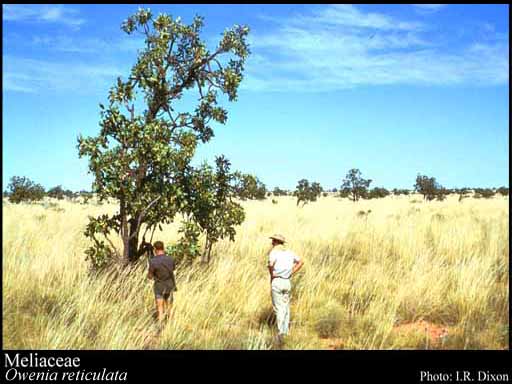- Reference
- Gen.Pl. [Jussieu] 263 (1789)
- Name Status
- Current

Scientific Description
Common name. Mahogany Family.
Habit and leaf form. Trees, or shrubs (or suckering shrublets), or herbs (rarely, e.g. Naregamia); laticiferous (rarely, with milky juice exuding from the bark), or with coloured juice; bearing essential oils. Stem growth conspicuously sympodial (rarely), or not conspicuously sympodial. Often pachycaul. Mesophytic. Leaves alternate (nearly always), or opposite (rarely, decussate); nearly always spiral; petiolate; non-sheathing; not gland-dotted; compound (usually), or simple; pinnate (mostly, pari- or imparipinnate), or unifoliolate (rarely), or ternate (rarely), or bifoliolate (very rarely), or bipinnate (very rarely). Leaf blades pinnately veined; cross-venulate. Leaves without stipules. Leaf blade margins entire (usually), or crenate, or serrate, or dentate (or lobed). Vegetative buds scaly, or not scaly. Leaves without a persistent basal meristem. Domatia recorded (6 genera); represented by pits, or pockets, or hair tufts. Stem anatomy. Nodes mostly penta-lacunar. Secondary thickening developing from a conventional cambial ring.
Reproductive type, pollination. Fertile flowers hermaphrodite, or functionally male and functionally female, or functionally male, or functionally female, or hermaphrodite, functionally male, and functionally female. Unisexual flowers present, or absent. Plants hermaphrodite (usually), or monoecious, or dioecious, or polygamomonoecious. Male flowers with pistillodes (present as well developed rudiments, perhaps important in pollination). Usually) entomophilous; via hymenoptera, or via lepidoptera. Pollination mechanism conspicuously specialized (via passive pollen presentation, involving stylar modifications, in at least a few genera), or unspecialized.
Inflorescence and flower features. Flowers solitary, or aggregated in ‘inflorescences’; in cymes, in racemes, in panicles, and in spikes. The terminal inflorescence unit cymose (usually, thyrsoid), or racemose. Inflorescences axillary (usually), or terminal, or leaf-opposed, or epiphyllous, or cauliflorous; usually paniculate with cymose branchlets (thyrsoid), less often racemose, fasciculate or spicate, or flowers paired or solitary. Flowers minute to large; operculate (calyptrate), or not operculate; regular; cyclic; tetracyclic to polycyclic. Free hypanthium absent. Hypogynous disk present, or absent; when present, intrastaminal; variable in form, stipitate, patelliform, cyathiform or tubular, free from or more or less fused with the bases of the staminal tube or ovary. Perianth with distinct calyx and corolla; (5–)6–12(–21); 2 -whorled, or 3 -whorled (the corolla sometimes in two whorls); isomerous, or anisomerous. Calyx (2–)3–5(–7) (sometimes transitional to bracteoles); 1 -whorled; gamosepalous (usually), or polysepalous; entire (occasionally, truncate or closed and circumcissile), or lobed; when not entire or polysepalous, lobulate, or blunt-lobed, or toothed; calyptrate (rarely); imbricate, or open in bud, or valvate (rarely, or almost closed when circumcissile); regular. Corolla 3–7(–14); 1 -whorled, or 2 -whorled; polypetalous, or gamopetalous (rarely basally united, but often fused with the staminal tube); imbricate, or contorted, or valvate (less often). Androecium in female flowers present (as well developed rudiments, at least sometimes significant in pollination). Fertile stamens present, or absent (in female flowers). Androecium (3–)5–10(–23), or 10–100 (to ‘many’, if appendages on the tube are treated as staminodial). Androecial members free of the perianth, or adnate (with the staminal tube adnate to the corolla); free of one another, or coherent (usually forming a staminal tube, which may be complete or incomplete, short or up to 14 cm long, globose, urceolate, campanulate, etc., or cylindrical and then sometimes curved or inflated distally, and which free or partially united appendages); when joined, 1 - adelphous; 1–21 -whorled (usually haplostemonous, sometimes with two stamen whorls, and up to many series of ‘appendages’). Androecium exclusively of fertile stamens, or including staminodes (the staminal tube being entire, crenate, lobed or bearing appendages). Staminodes when present, 5–100 (as many as the stamens, or twice the number, rarely up to ten times the number). Stamens (3–)5–10(–23); isomerous with the perianth, or diplostemonous; usually alternating with appendages, sometimes opposite them; filantherous, or petaloid, or petaloid and with sessile anthers (often with the anthers sessile on the corolla-like staminal tube). Anthers more or less dorsifixed; versatile; dehiscing via longitudinal slits; introrse; tetrasporangiate. Pollen shed in aggregates (rarely), or shed as single grains; rarely in tetrads. Fertile gynoecium present, or absent (in male flowers). Gynoecium (1–)2–6(–20) carpelled. The pistil (1–)2–6(–20) celled. Carpels reduced in number relative to the perianth to increased in number relative to the perianth. Gynoecium syncarpous; synstylovarious, or eu-syncarpous; superior. Ovary unilocular to plurilocular; (1–)2–6(–20) locular (reflecting the carpel number). Gynoecium non-stylate to stylate. Styles when demarcated, 1; when perceptible, attenuate from the ovary, or from a depression at the top of the ovary; apical. Stigmas 1; variously clavate, or capitate, or subpeltate to peltate (commonly forming a conspicuous receptaculum pollinis); wet type; papillate; Group III type. Placentation when unilocular (i.e. occasionally), parietal; usually axile. Ovules in the single cavity when unilocular 1, or 2, or 3–100 (i.e. one to ‘many’); 1–2 per locule (Melioideae), or 3–50 per locule (i.e. one to ‘many’, in Swietenioideae); usually pendulous; epitropous; with ventral raphe (micropyle superior); collateral, or superposed, or biseriate; arillate (Melioideae), or non-arillate (Swietenioideae); orthotropous, or anatropous, or campylotropous.
Fruit and seed features. Fruit fleshy, or non-fleshy; dehiscent, or indehiscent; a capsule, or a berry, or a drupe, or a nut (rarely). Capsules septicidal, or loculicidal. Seeds endospermic (rarely), or non-endospermic; winged (Swietenioideae), or wingless. Embryo well differentiated. Cotyledons 2. Embryo chlorophyllous (5/6), or achlorophyllous (3/4); straight, or curved. Seedling. Germination phanerocotylar, or cryptocotylar.
Physiology, biochemistry. Aluminium accumulation not found.
Geography, cytology, number of species. World distribution: pantropical to subtropical and warm. X = 10–14(+). 575 species.
Economic uses, etc. Edible fruit from Lansium domesticum (langsat, ayer-ayer); timber from Swietenia (mahogany), Kaha (African mahogany).